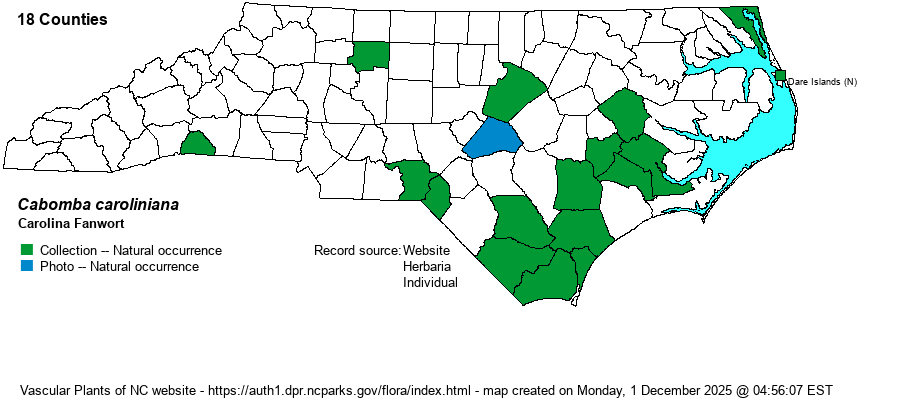| Author | A. Gray | |
| Distribution | Throughout the southeastern quarter of the state, north to Pender and Bladen counties, but spottily found elsewhere in the southern half of the Coastal Plain. Only a few scattered records for the northern Coastal Plain and the Piedmont; no known Mountain records.
Widely scattered over much of the eastern states, though mainly coastal and up the Mississippi River valley. Ranges north to MA, IL, and MO, south to FL and TX. Also considered native in southcentral S.A.
| |
| Abundance | Rare to uncommon in the Coastal Plain as a whole; slightly more numerous, but still uncommon, in the southernmost counties. Extremely rare in the Piedmont. It is considerably less common than Brasenia, and about equally numerous (i.e., scarce) as Limnobium, other somewhat "unique" aquatic species that grow in the same or very similar habitats. | |
| Habitat | This species favors shallow and still waters, such as millponds, impoundments, lakes, swamp openings, and slow-moving streams. | |
| Phenology | Blooms and then fruits from May to September. | |
| Identification | This aquatic species has basically just submerged stems and leaves, though a few leaves may be present floating at the surface. Nonetheless, all of these leaves are linear or filamentous (i.e., very feathery), and are mostly inconsequential to identification, unless you are inclined to pull up such "stringy" plants for later identification. The primary visual part of the plant is the inflorescence, consisting of a few flowers (singly from leaf axils) projecting out of the water just 1-2 inches. The flower typically has 3 somewhat square or rectangular white petals, and nearly identical 3 white sepals, to give a 6-armed flower about 1 inch across in the shape of a wheel. If the flowers are present, you should quickly be able to identify it, as hardly any other aquatic plant has a 6-"petaled" white flower on a stalk barely poking out of the water. The vegetative part of the plant resembles some species in the genera Myriophyllum and Proserpinaca. This is a difficult floating plant to find, owing mainly to its somewhat scarcity and also to it being overlooked if not in bloom. | |
| Taxonomic Comments | A few references list varieties for it, but most do not (including Weakley 2018).
| |
| Other Common Name(s) | Fanwort | |
| State Rank | S3? [S2S3] | |
| Global Rank | G3G5 | |
| State Status | | |
| US Status | | |
| USACE-agcp | OBL link |
| USACE-emp | OBL link |

